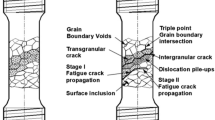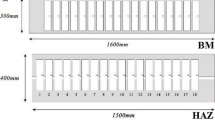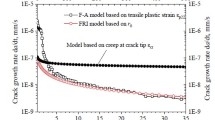Abstract
This paper presents a model of fatigue crack growth in a welded joint and a two-dimensional model of anodic dissolution based on Donahue model and anodic dissolution mechanism, respectively. In addition, a model for predicting the corrosion fatigue crack growth rate in welded joints of steel marine structures is established and crack growth mechanisms are analyzed. The results show that during early stages of crack growth, corrosion fatigue crack growth rate in welded joints is mainly controlled by corrosion action, whereas cyclic loading becomes more influential during the later stage of crack propagation. Loading frequency and effective stress ratio can affect rupture period of protective film at the corrosion fatigue crack tip and the length of corrosion crack increment, respectively, which changes the influence of corrosion action on crack growth rate. However, the impact of stress amplitude on crack growth rate is only significant when crack propagation is caused by cyclic loading. Welding residual stress not only improves the effective stress ratio of cyclic loading, but also promotes crack closure and increases corrosion fatigue crack growth rate in welded joints. Compared to corrosion action, welding residual stress has a more significant influence on crack growth caused by cyclic loading.
摘要
本文分别基于 Donahue 模型和阳极溶解机理, 提出了焊接接头疲劳裂纹扩展模型和阳极溶解二维模型。 此外, 建立了预测海洋钢结构焊接接头腐蚀疲劳裂纹扩展速率的模型, 并分析了裂纹扩展机理。 结果表明, 在裂纹扩展的早期阶段, 焊接接头的腐蚀疲劳裂纹扩展速率主要受腐蚀作用控制, 而在裂纹扩展的后期, 受到循环载荷的影响更大。 加载频率和有效应力比会分别影响保护膜在腐蚀疲劳裂纹尖端的破裂时间和腐蚀裂纹扩展长度, 从而改变腐蚀作用对裂纹扩展速率的影响。 但是, 应力振幅对裂纹扩展速率的影响仅在周期性载荷引起裂纹扩展时才显着。 焊接残余应力不仅提高了循环载荷的有效应力比, 而且还促进了裂纹的闭合并提高了焊接接头的腐蚀疲劳裂纹扩展率。 与腐蚀作用相比, 焊接残余应力对循环载荷引起的裂纹扩展的影响更大。
Similar content being viewed by others
Abbreviations
- SIF:
-
Stress intensity factor
- ΔK :
-
SIF range
- ΔK th :
-
Threshold of SIF range
- \(K_{{\rm{eff}}}^{\max }\) :
-
Maximum effective SIF
- \(K_{{\rm{eff }}}^{\min }\) :
-
Minimum effective SIF
- K res :
-
SIF increment due to welding residual stress
- C, m :
-
Material constants
- Φ 0 :
-
Complete elliptic integral of the second kind
- M s :
-
Free surface correction coefficient
- M T :
-
Finite thickness correction factor
- M k :
-
Weld toe correction factor
- Δσ :
-
Actual stress amplitude
- Δσ eff :
-
Effective stress amplitude
- σ max :
-
Maximum cyclic stress
- σ f :
-
Flow stress
- σ y :
-
Yield strength
- σ u :
-
Tensile strength
- \(\sigma _0^{{\rm{res}}}\) :
-
Welding residual stress at the crack tip
- c :
-
Semi-elliptical surface crack length
- a :
-
Crack depth
- B :
-
Welded plate thickness
- θ :
-
Parameter related to the residual height of the welded joint
- χ :
-
Shape coefficient
- R :
-
Stress ratio
- R eff :
-
Effective stress ratio
- a th :
-
Fatigue crack growth threshold
- b 1 :
-
Fatigue strength factor
- U :
-
Opening ratio
- α :
-
Stress-strain constraint coefficient
- f :
-
Loading frequency
- \({\bar V_{\rm{t}}}\) :
-
Anodic dissolution crack growth
- Q f :
-
Oxidation charge density
- ε et :
-
Strain rate at the crack tip
- εf :
-
Rupture strain of oxide film
- n :
-
Number of electrons released
- F :
-
Faraday’s constant
- M :
-
Molar mass
- ρ :
-
Metal density
- i 0 :
-
Corrosion current density
- λ :
-
Passivation coefficient of current attenuation
- t d :
-
Passivating time required for generating passivated film
- T :
-
Time of oxide film rupture at the crack tip
- w m :
-
Average width of crack increment
References
DENG L, YAN W C, NIE L. A simple corrosion fatigue design method for bridges considering the coupled corrosion-overloading effect [J]. Engineering Structures, 2019, 178: 309–317. DOI: https://doi.org/10.1016/j.engstruct.2018.10.028.
SUN J Z, DING Z H, HUANG Q. Corrosion fatigue life prediction for steel bar in concrete based on fatigue crack propagation and equivalent initial flaw size [J]. Construction and Building Materials, 2019, 195: 208–217. DOI: https://doi.org/10.1016/j.conbuildmat.2018.11.056.
WANG S Q, ZHANG D K, HU N N, ZHANG J L. Effect of stress ratio and loading frequency on the corrosion fatigue behavior of smooth steel wire in different solutions [J]. Materials, 2016, 9: 750–766. DOI: https://doi.org/10.3390/ma9090750.
ZHAO W M, WANG Y X, ZHANG T M, WANG R. Study on the mechanism of high-cycle corrosion fatigue crack initiation in X80 steel [J]. Corrosion Science, 2012, 57: 99–103. DOI: https://doi.org/10.1016/j.corsci.2011.12.029.
CHANG H. Acoustic emission study of corrosion fatigue crack propagation mechanism identification [J]. Applied Mechanics and Materials, 2014, 628: 20–23. DOI: https://doi.org/10.4028/www.scientific.net/AMM.628.20.
WU Q, CHEN X, FAN Z. Corrosion fatigue behavior of FV520B steel in water and salt-spray environments [J]. Engineering Failure Analysis, 2017, 79: 422–430. DOI: https://doi.org/10.1016/j.engfailanal.2017.05.012.
GARCÍA-RENTERÍA M A, LÓPEZ-MORELOS V H, GONZÁLEZ-SÁNCHEZ J, GARCIA-HERNANDES R, DZIB-PEREZ L, CURIEL-LOPEZ F F. Effect of electromagnetic interaction during fusion welding of AISI 2205 duplex stainless steel on the corrosion resistance [J]. Applied Surface Science, 2016, 396: 1187–1200. DOI: https://doi.org/10.1016/j.apsusc.2016.11.109.
BESTEN H. Fatigue damage criteria classification, modelling developments and trends for welded joints in marine structures [J]. Ships and Offshore Structures, 2018, 13: 787–808. DOI: https://doi.org/10.1080/17445302.2018.1463609.
GKATZOGIANNIS S, WEINERT J, ENGELHARDT I, KNOEDEL P, UMMENHOFER T. Correlation of laboratory and real marine corrosion for the investigation of corrosion fatigue behaviour of steel components [J]. International Journal of Fatigue, 2019, 126: 90–102. DOI: https://doi.org/10.1016/j.ijfatigue.2019.04.041.
GANDHI P, MURTHY D S R, RAGHAVA G, RAO A G M. Fatigue crack growth in stiffened steel tubular joints in seawater environment [J]. Engineering Structures, 2000, 22: 1390–1401. DOI: https://doi.org/10.1016/S0141-0296(99)00080-2.
WANG L, HUI L, ZHOU S, XU L, HE B. Effect of corrosive environment on fatigue property and crack propagation behavior of Al 2024 friction stir weld [J]. Transactions of Nonferrous Metals Society of China, 2016, 26: 2830–2837. DOI: https://doi.org/10.1016/S1003-6326(16)64411-4.
ILMAN M N, TRIWIBOWO N A, WAHYUDIANTO A, MUSLIH M R. Environmentally assisted fatigue behaviour of stress relieved metal inert gas (MIG) AA5083 welds in 3.5% NaCl solution [J]. International Journal of Fatigue, 2017, 100: 285–295. DOI: https://doi.org/10.1016/j.ijfatigue.2017.03.041.
DONAHUE T M, GUENTHER B, BLAMONT J E. Noctilucent clouds in daytime circumpolar particular layers near the summer mesopause [J]. Journal of the Atmospheric Science, 1972, 29: 1205–1209. DOI: https://doi.org/10.1175/1520-0469(1972)0292.0.CO;2.
PARIS P C, ERDOGEN F. A critical analysis of crack propagation laws [J]. Journal of Basic Engineering, 1963, 85: 528–533. DOI: https://doi.org/10.1115/1.3656900.
FORMAN R G. Numerical analysis of crack propagation in cyclic loaded structures [J]. Journal of Basic Engineering, Transaction ASTM (Series D), 1967, 89: 459–469. DOI: https://doi.org/10.1115/1.3609637.
BOWNESS D, LEE M M K. Prediction of weld toe magnification factors for semielliptical cracks in T-butt joints [J]. International Journal of Fatigue, 2000, 22: 389–396. DOI: https://doi.org/10.1016/S0142-1123(00)00012-8.
HUANG X P, CUI W C, SHI D X. Calculation of fatigue life of surface cracks at weld toe of submarine cone-cylinder shell [J]. Journal of Ship Mechanics, 2002, 6: 62–68. DOI: https://doi.org/10.3969/j.issn.1007-7294.2002.04.007. (in Chinese)
YU Y G. Calculations and assessment for cracking strength to linear elastic materials in whole process-the genetic elements and clone technology in mechanics and engineering fields [J]. American Journal of Science and Technology, 2016, 3: 152–161. http://www.aascit.org/journal/ajst.
VOJTEK T, POKORNY P, KUBENA I, NAHLIK L, FAJKOS R, HUTAR P. Quantitative dependence of oxide-induced crack closure on air humidity for railway axle steel [J]. International Journal of Fatigue, 2019, 123: 213–224. DOI: https://doi.org/10.1016/j.ijfatigue.2019.02.019.
WU S C, LI C H, LUO Y, ZHANG H O, KANG G Z. A uniaxial tensile behavior based fatigue crack growth model [J]. International Journal of Fatigue, 2020, 131: 105324. DOI: https://doi.org/10.1016/j.ijfatigue.2019.105324.
MAIERHOFER J, PIPPAN R, GANSER H P. Modified NASGRO equation for physically short cracks [J]. International Journal of Fatigue, 2014, 59: 200–207. DOI: https://doi.org/10.1016/j.ijfatigue.2013.08.019.
NEWMAN J C. A Crack opening stress equation for fatigue crack growth [J]. International Journal of Fracture, 1984, 24: 131–135. DOI: https://doi.org/10.1007/BF00020751.
ZHANG H T, CHEN Y Z. Deformation and fracture of solids [M]. Beijing: Higher Education Press, 1989. (in Chinese)
FETT T. Evaluation of the bridging relation from crack-opening-displacement measurements by use of the weight function [J]. Journal of the American Ceramic Society, 1955, 78: 945–948. DOI: https://doi.org/10.1111/j.1151-2916.1995.tb08419.x.
BAI L Y, GAO L, JIANG K B. Corrosion crack nucleation mechanism in the welded structures of X65 steel in natural seawater [J]. Advances in Materials Science and Engineering, 2018, 2018: 8973150. DOI: https://doi.org/10.1155/2018/8973150.
SIVAPRASAD S, TARAFDER S, RANGANATH V R. Corrosion fatigue crack growth behavior of naval steels [J]. Corrosion Science, 2006, 48: 1996–2013. DOI: https://doi.org/10.1016/j.corsci.2005.08.005.
ONORO J. Corrosion fatigue behaviour of 317LN austenitic stainless steel in phosphoric acid [J]. International Journal of Pressure Vessels and Piping, 2009, 86: 656–660. DOI: https://doi.org/10.1016/j.ijpvp.2009.06.001.
KYRYLIV V, CHAIKOVS’KYI B, MAKSYMIV O, MYKYTCHAK B. Fatigue and corrosion fatigue of the roll steels with surface nanostructure [J]. Journal of Nano Research, 2018, 51: 92–97. DOI: https://doi.org/10.4028/www.scientific.net/JNanoR.51.92.
NAKAI T, MATSUSHITA H, YAMAMOTO N, ARAI H. Effect of pitting corrosion on local strength of hold frames of bulk carriers (1st report) [J]. Marine Structure, 2004, 17: 403–432. DOI: https://doi.org/10.1016/j.marstruc.2004.10.001.
PAIK J K. Ultimate shear strength of plate elements with pit corrosion wastage [J]. Thin-Walled Structures, 2004, 42: 1161–1176. DOI: https://doi.org/10.1016/j.tws.2004.03.024.
WEI R P, LANDES J D. The effect of D2O on fatigue-crack propagation in a high-strength aluminum alloy [J]. International Journal of Fracture Mechanics, 1969, 5: 69–71. DOI: https://doi.org/10.1007/BF00189941.
FORD E D, SORRENSEN K A. Theory and models of inter-plant competition as a spatial process, in individualbased models and approaches in ecology [J]. Populations, Communities and Ecosystems, 1992, 109: 363–407. DOI: https://doi.org/10.1007/978-1-4757-0869-1_17.
SHOJI T, LU Z, MURAKAMI H. Formulating stress corrosion cracking growth rates by combination of crack tip mechanics and crack tip oxidation kinetics [J]. Corrosion Science, 2010, 52: 769–779. DOI: https://doi.org/10.1016/j.corsci.2009.10.041.
ENGELHARDT G R, MACDONALD D D. Modelling the crack propagation rate for corrosion fatigue at high frequency of applied stress [J]. Corrosion Science, 2010, 52: 1115–1122. DOI: https://doi.org/10.1016/j.corsci.2009.11.031.
WAHAB M A, SAKANO M. Experimental study of corrosion fatigue behavior of welded steel structures [J]. Journal of Materials Processing Technology, 2001, 118: 117–122. DOI: https://doi.org/10.1016/S0924-0136(01)00902-5.
KNOP M, HEATH J, STERJOVSKI S P, LYNCH S P. Effects of cycle frequency on corrosion-fatigue crack growth in cathodically protected high-strength steels [J]. Procedia Engineering, 2010, 2: 1243–1252. DOI: https://doi.org/10.1016/j.proeng.2010.03.135.
ADEDIPE O, BRENNAN F, MEHMANPARAST A, LYNCH S P. Corrosion fatigue crack growth mechanisms in offshore monopile steel weldments [J]. Fatigue & Fracture of Engineer Materials & Structures, 2017: 1–14. DOI: https://doi.org/10.1111/ffe.12606.
Author information
Authors and Affiliations
Contributions
SHAO Fei provided the concept and edited the draft of manuscript. XU Qian and BAI Lin-yue conducted theoretical analysis. XU Qian conducted manuscript writing, data analysis, and edited the draft of manuscript. MA Qing-na conducted a literature review survey. SHEN Mei conducted data verification and icon verification nuclear.
Corresponding authors
Additional information
Conflict of interest
XU Qian, SHAO Fei, BAI Lin-yue, MA Qing-na and SHEN Mei declare that they have no conflict of interest.
Foundation item
Project(2018M643852) supported by the Postdoctoral Science Foundation of China; Projects(30110010403, 30110030103) supported by Equipment Pre-Research Project, China; Project(51979280) supported by the National Natural Science Foundation of China
Rights and permissions
About this article
Cite this article
Xu, Q., Shao, F., Bai, Ly. et al. Corrosion fatigue crack growth mechanisms in welded joints of marine steel structures. J. Cent. South Univ. 28, 58–71 (2021). https://doi.org/10.1007/s11771-021-4586-0
Received:
Accepted:
Published:
Issue Date:
DOI: https://doi.org/10.1007/s11771-021-4586-0




